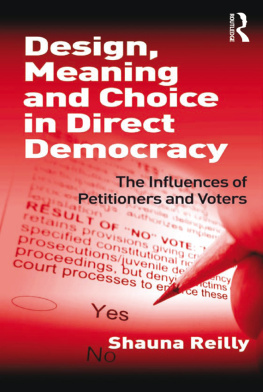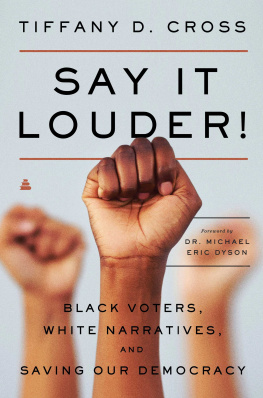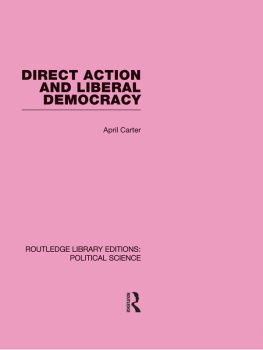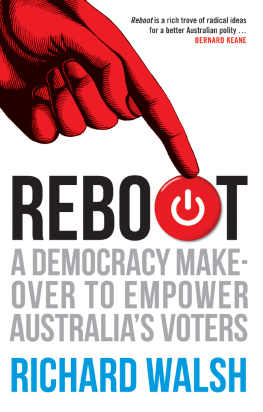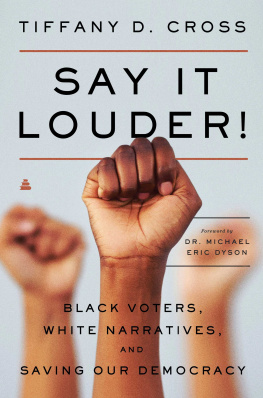First published 2010 by Ashgate Publishing
Published 2016 by Routledge
2 Park Square, Milton Park, Abingdon, Oxon OX14 4RN
711 Third Avenue, New York, NY 10017, USA
Routledge is an imprint of the Taylor & Francis Group, an informa business
Copyright 2010 Shauna Reilly
Shauna Reilly has asserted her right under the Copyright, Designs and Patents Act, 1988, to be identified as the author of this work.
All rights reserved. No part of this book may be reprinted or reproduced or utilised in any form or by any electronic, mechanical, or other means, now known or hereafter invented, including photocopying and recording, or in any information storage or retrieval system, without permission in writing from the publishers.
Notice:
Product or corporate names may be trademarks or registered trademarks, and are used only for identification and explanation without intent to infringe.
British Library Cataloguing in Publication Data
Reilly, Shauna.
Design, meaning and choice in direct democracy : the influences of petitioners and voters.
1. Direct democracy--United States. 2. Political participation--United States. 3. Referendum--United States.
I. Title
328.273-dc22
Library of Congress Cataloging-in-Publication Data
Reilly, Shauna, 1938-
Design, meaning, and choice in direct democracy : the influences of petitioners and voters / by Shauna Reilly.
p. cm.
Includes bibliographical references and index.
ISBN 978-1-4094-0973-1 (hardback)
1. Direct democracy--United States. 2. Referendum--United States. 3. Political participation--United States. I. Title.
JF494.R45 2010
328.273--dc22
2010026846
ISBN 9781409409731 (hbk)
ISBN 9781315576701 (ebk)
Foreword
The Mob and Democracy: Paying Attention to Direct Democracy Ballot Measures
The recent surge in research on direct democracy in the United States is an important development in political science literature. From its beginnings, the danger associated with a democratic system of government was its susceptibility to rule by the mob an epithet designed to convey both the lack of qualifications and ability held by regular people, and the dangers that could result in handing power to a group of such people. The solution to mob rule, argued by generations of defenders of the democratic system, is republican government. Elected officials are the buffer that stands between the people and policymaking, and who protect a polity from policy that panders to the majority without consideration for the greater good.
Direct democracy elections, initiatives and referenda that allow citizens to enact policy, can be seen as a way to give policymaking powers over to the mob. States that allow citizens a final say as to what is or is not the law, and there are many, may be welcoming those who are uninformed, or disinterested, or selfishly unconcerned with responsible policymaking, to the lawmaking process. In addition, if voters are largely unqualified to evaluate complicated policy alternatives, the system is also open to manipulation on the part of elites. That is, those who propose ballot initiatives may do so because they believe their prospects for success are better with the less informed populace than with legislators who might see the problems with such proposals.
There is a need for someone to investigate the motives of those who choose the direct democracy route for altering policy in a state, the ability of voters to handle policymaking and the issues that come up on direct democracy proposals, and whether or not those who end up casting votes on policy proposals are informed enough to be entrusted with such responsibility. Fortunately, Dr Shauna Reillys study of these very issues is contained in this book.
This book asks a series of important questions. Most generally: do direct democracy elections contribute to the kind of policymaking that critics of classical democracy warn us about? More specifically: do narrow interests manipulate the system with the intent of enacting policies that serve those narrow interests? Moreover, do voters in direct democracy elections know little about government in general, and too little about the issues they are asked to consider in order to participate meaningfully?
The role direct democracy plays in the political system of the United States can be one that lives up to the role envisioned by the progressives of the late 19th and early 20th centuries. It is certainly possible that petitioners typically see an issue that a corrupt or unresponsive legislature will not address, and use the initiative process to bring their proposal to the people who recognize the need addressed by the proposal and vote the proposal into law (or, in the case of a referendum, prevent a bad policy produced by an unrepresentative legislature from becoming law). It is also certainly possible, however, that the pessimistic view of direct democracy better describes the process in the real world: that is, opportunistic interests manipulate citizens into enacting a law with obscure language and narrow goals.
The question as to which scenario better describes how direct democracy works in the United States is essential to understanding how well states represent their citizens, and what tools exist to enhance or diminish that representation. This books takes several approaches to investigating how direct democracy in the United States works. Dr Reilly applies three very different tools in her analysis.
First, she surveys petitioners who propose ballot initiatives (in Oregon, in this study) to determine the reasons for their proposals and how they view the public. The surveys reveal that the distribution of opinions petitioners have about the initiative process and about voters are not uniform, and that an important distinction exists separating petitioners who believe that citizens are sophisticated from those who think citizens are unsophisticated. This distinction is related to the extent to which petitioners work to educate voters about the issues. This finding has an important relationship with other work being performed in the discipline regarding the role direct democracy campaigns play in informing citizens, and suggests yet again that direct democracy can play a significant role in both shaping the opinions of citizens and in determining other votes citizens will cast in elections. From this point of view, direct democracy can serve to empower the population. On the other hand, Reilly finds that most petitioners do not have high opinions of citizen sophistication and, therefore, do not emphasize education in their attempts to persuade voters. In addition, when it comes to forming the language of the ballot petition itself, she finds that a potential method of educating citizens, the ballot question itself, is most often neglected in terms of readability and problematic for citizens.
Reilly then uses statistical methods to analyze the role language complexity plays in determining ballot roll-off rates in direct democracy elections. This includes: ballot wording, topic, and ease of issue. While we expect voters to evaluate the merits of complex policy proposals when we ask them to vote for or against laws themselves, it is certainly possible that the content used in proposals could hinder participation. Indeed, in the analyses in this book, Dr Reilly determines what characteristics of this ballot content are associated with ballot roll-off, and what characteristics are not.


